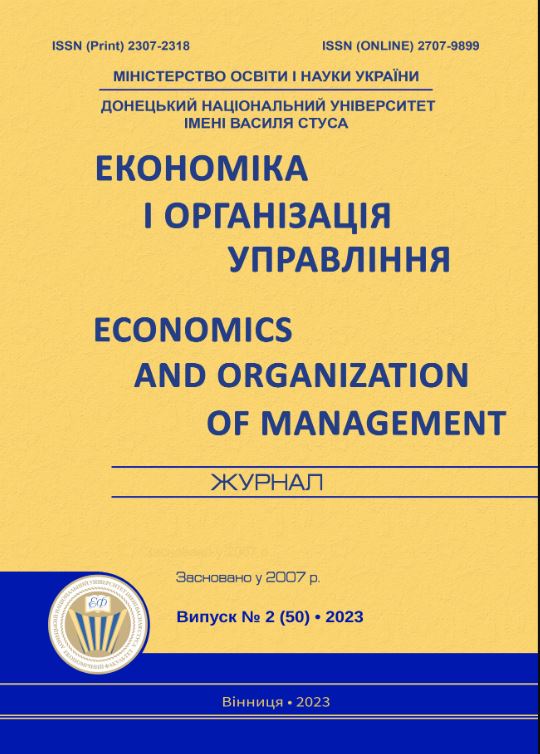Digital transformation of global value chain
DOI:
https://doi.org/10.31558/2307-2318.2023.2.10Keywords:
global value chains; digital transformation; digitalization; industry 4.0; world tradeAbstract
The article is devoted to the study of the process of transformation of global value chains under the influence of digitalization. The paper compares the features of virtual and classic value chains based on the definition of specific characteristics - collection, organization, selection, generalization and dissemination of information. The study focuses on examining five main modes of supply in e-commerce, which include: supply of electronic services and goods, three modes based on electronic intermediation, and capitalization of information flows. It is determined that the technologies of the fourth industrial revolution can allow firms to reduce the number of steps in value chains by moving routine labor-intensive activities from developing countries back to developed countries. The work emphasizes that due to the emergence of the process of glocalization, regional ties can be strengthened - an important role will be assigned to regional integration associations, which can become the basis for value chains. On the basis of the case analysis, it was determined that the hierarchical type of management in HLSW also has its imprint in the process of digitalization of chains through the spread of startups by multinational companies, especially those represented in the field of software development. It was noted that the introduction of new technologies, the reduction of the length of chains, as well as the importance of regional processes led to the development of decentralized production - the growing importance of regional integrations, which can become the basis of innovative interaction, and technology transfer systems made it possible to locate production closer to the consumer, moreover, it provided the opportunity for small and medium-sized businesses to become more actively involved in production processes. The work also pays attention to the phenomenon of the emergence of more and more global ecosystems, which allow small and medium-sized businesses to integrate into global processes. Thus, an invasive type of management within global value chains, where small and medium-sized businesses depend on the global systems of multinational companies, becomes relevant.
References
Дугінець. Г.В. Глобальні ланцюги вартості: монографія. Київ: Київ. нац. торг.-екон. ун-т. 2018. 412 с.
Черкас Н. Концепції глобальних мереж таланцюгів створення вартості. Вісник Київського національного торговельно-економічного університету. 2018. №3. С. 60–70.
Гірна, О.Б. Локальні та глобальні аспекти формування доданої вартості у ланцюгу поставок. Цифрова економіка та економічна безпека. 2022. №1. С. 22-28.
Rayport J. F., Sviokla J. J. (1995) Exploiting the Virtual Value Chain Harvard Business Review. Nov. / Dec. P. 5 – 16.
Ciuriak D., Ptashkina M. (2018). The Digital Transformation and the Transformation of International Trade. RTA Exchange.
Rüßmann, M., Lorenz, M., Gerbert, P., Waldner, M., Justus, J., Engel, P., & Harnisch, M. (2015). Industry 4.0: The future of productivity and growth in manufacturing industries. Boston consulting group, 9(1), 54-89.
Schwab K. The Fourth Industrial Revolution: what it means, how to respond. World Economic Forum. 2016. URL: https://www.weforum.org/agenda/2016/01/the-fourth-industrial-revolution-what-it-means-and-how-to-respond/
Atzori L., Iera A., Morabito G. The internet of things: A survey // Computer networks. 2010. Т. 54. №. 15. С. 2787-2805.
Khondker, H. H. (2005). Globalisation to Glocalization: A Conceptual Exploration. Intellectual Discourse, 13(2): 181–99.
De Backer, K. and Flaig, D. (2017). The future of global value chains. Business as usual or “a new normal”? Science, Technology and Industry. Working Paper No. 41. Paris: OECD. URL: http://www.iberglobal.com/files/2017-2/GVCs-_future_OCDE.pdf
Lundquist, K. J., Trippl, M. (2013). Distance, proximity and types of cross-border innovation systems: A conceptual analysis. Regional studies, 47(3), 450-460.
TotalCare Rolls Royce. URL: https://www.rolls-royce.com/media/our-stories/discover/2017/totalcare.aspx
Access by BWM. URL: https://www.accessbybmw.com/
Global Value Chain Development Report 2019: Technological Innovation, Supply Chain Trade, and Workers in a Globalized World. Geneva: World Trade Organization, 2019. 183 p. URL: http://documents.worldbank.org/curated/en/384161555079173489/pdf/Global-ValueChain-Development-Report-2019-Technological-Innovation-Supply-Chain-Trade-and-Workersin-a-Globalized-World.pdf

